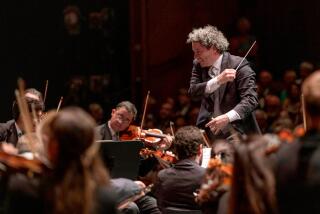Review: Concertos take the lead at L.A. Phil, L.A. Chamber Orchestra
The concerto is a way of symphonic life. Orchestras spend a lot of money to bring in star soloists to play them, typically in the first half of the concert, and they tend to come from a standard pool of around 50 favorites.
Yet the real news at orchestra concerts is, more often than not, the orchestra. After intermission comes symphony time, and that tends to be the bigger musical deal.
Over the weekend, however, the Los Angeles Philharmonic and the Los Angeles Chamber Orchestra made concertos the main attraction. The L.A. Phil gave the L.A. premiere of Polish composer Krzysztof Penderecki’s Concerto Grosso for Three Cellos. LACO had the L.A. premiere of American composer Aaron Jay Kernis’ Viola Concerto, along with the Beethoven Third Piano Concerto, which took the place of a purely symphonic score in the second half of the program.
Penderecki’s concerto, premiered 13 years ago in Tokyo, vaguely follows the Baroque concerto grosso format of a small group of soloists in opposition to a large group of players. Typical of Baroque concertos, it is in several short movements, but Penderecki turns small forms into large. The sections are played without pause in a single 36-minute movement. The tone is somber. The style is derivative of Shostakovich. The three cellos bow robustly.
Penderecki does not exploit the theatrical conflict of the little guy (or guys) against the masses, which is often the central business of a concerto. Soloists and orchestra remain on the same emotional page with extrovert drama coming from exploitation of sonic resources (especially with colorful percussion).
Kernis’ Viola Concerto — which had its first performance earlier this year in St. Paul, Minn., and of which LACO is one of four commissioners — is more conventional on the surface but richer in its inner working. It is a traditional three-movement work for a solo instrument, but instead of a series of dramatic instances, it expresses a deep-seated goal.
That goal is to explore the substance behind the Yiddish folk song “Tumbalalaika.” It begins as a young man’s simple quest for romance, which is ultimately a search for the meaning of life and death. Happiness, he must accept, is ever fleeting.
Throughout the concerto, Kernis supplies musical cues for the familiar, ingratiating “Tumbalalaika” tune, with the viola leading what sounds like an archaeological dig through distant harmonies and melodies. When we finally uncover “Tumbalalaika,” it is so encrusted with what has come before that it is only fleetingly recognizable.
Music, here, serves as an illuminating metaphor for happiness. A song we might try to hold onto throughout our lives (as Kernis has with “Tumbalalaika,” which was sung to him by his mother) can never be separated from its history or from the lives we lead.
Both concertos got very good performances. Kernis wrote his at the request of violist Paul Neubauer, who has a gorgeously soulful tone. There aren’t all that many exceptional concertos for his instrument, so another is treasure.
Penderecki wrote his concerto grosso at the behest of the conductor Charles Dutoit, who was to have conducted the L.A. Phil, but was ill and replaced by a young Romanian conductor, Cristian Macelaru. The three cellists were Claudio Bohórquez, Arto Noras and Li-Wei Qin.
What surrounded the concertos made an interesting difference. LACO’s Music Director Jeffrey Kahane surrounded Kernis with quirky, colorful short excerpts from three Rameau operas — French Baroque music with color — and the Beethoven Third Concerto, conducted from the keyboard.
Kahane has played this concerto many times, but he was on fire Saturday night at the Alex Theatre in Glendale, conveying Beethoven as a wild force of nature on a spiritual journey.
I caught Macelaru at the Sunday matinee in Walt Disney Concert Hall. He retained Dutoit’s original program, beginning with a beautifully nuanced and atmospheric reading of Ravel’s “Rhapsodie Espagnole” and ending with Elgar’s “Enigma” Variations. That meant a program of French music (in a Spanish vein), Polish music (in a Russian vein) and an all-English finish.
Macelaru was, in the “Enigma,” alternatively bombastic, suave, tender, rapt. When he wasn’t too slow or too loud, he was terrific in his ability to convey colorful orchestral character. The resident conductor of the Philadelphia Orchestra, Macelaru is someone to watch.
Twitter: @markswed
More to Read
The biggest entertainment stories
Get our big stories about Hollywood, film, television, music, arts, culture and more right in your inbox as soon as they publish.
You may occasionally receive promotional content from the Los Angeles Times.











